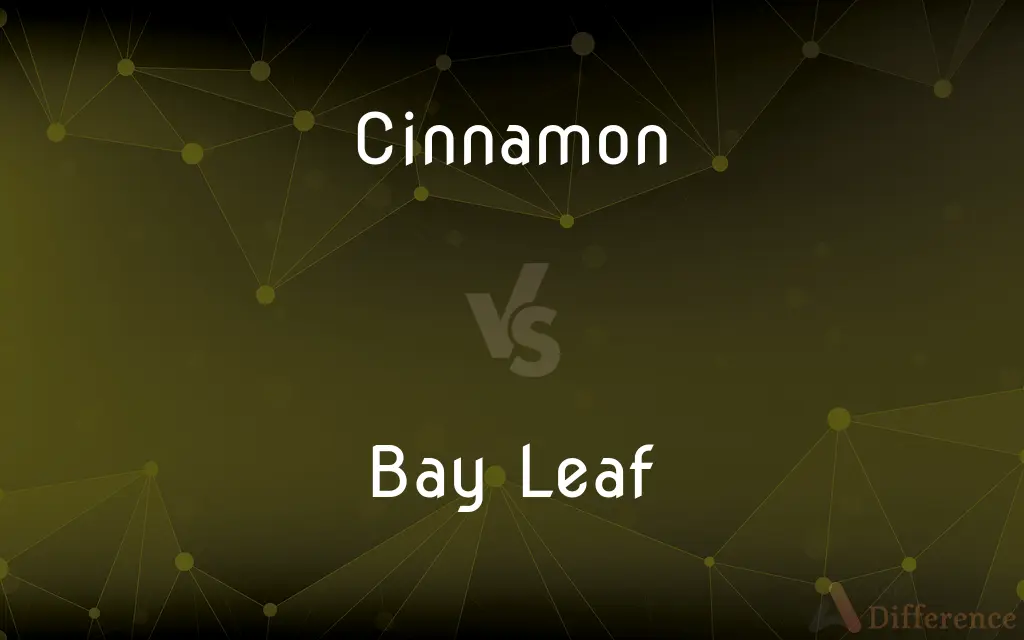Cinnamon vs. Bay Leaf — What's the Difference?
By Tayyaba Rehman — Published on January 23, 2024
Cinnamon, derived from tree bark, offers a sweet and spicy flavor, commonly used in desserts, while Bay Leaf, a leaf from the laurel tree, provides a subtle, herbal aroma, used in savory dishes.

Difference Between Cinnamon and Bay Leaf
Table of Contents
ADVERTISEMENT
Key Differences
Cinnamon is obtained from the inner bark of several tree species from the genus Cinnamomum, known for its distinct sweet and spicy flavor. Bay Leaf, on the other hand, comes from the laurel tree and is used for its mild and herbal aroma in cooking.
Cinnamon is often used in powdered form or as whole cinnamon sticks in various cuisines, especially in sweet dishes like pastries and hot drinks. Bay Leaves are typically used whole in soups, stews, and other savory dishes and removed before serving.
The flavor profile of Cinnamon is warm and aromatic, with a hint of sweetness, making it a favorite in baking and dessert recipes. Bay Leaf imparts a subtle, earthy flavor and is often used to complement other herbs and spices in cooking.
In terms of health benefits, Cinnamon is known for its antioxidant properties and potential benefits in blood sugar regulation. Bay Leaves contain compounds that can aid in digestion and provide anti-inflammatory effects.
Cinnamon is a staple in many spice blends, including garam masala and pumpkin spice, and is also used in various cultural cuisines. Bay Leaves are a common ingredient in bouquet garni and are essential in many European and Asian dishes.
ADVERTISEMENT
Comparison Chart
Source
Inner bark of Cinnamomum trees
Leaves of the laurel tree
Flavor
Sweet, spicy, warm
Subtle, herbal, earthy
Common Use
Desserts, baking, drinks
Soups, stews, savory dishes
Form
Ground powder, sticks
Whole leaves
Health Benefits
Antioxidant, blood sugar regulation
Aids digestion, anti-inflammatory
Compare with Definitions
Cinnamon
Cinnamon is a spice from the inner bark of Cinnamomum trees.
Cinnamon added a warm flavor to the apple pie.
Bay Leaf
Bay Leaf is a culinary herb from the laurel tree.
I added a Bay Leaf to the soup for a herbal flavor.
Cinnamon
Cinnamon is known for its sweet and spicy taste.
I love the spicy sweetness cinnamon brings to my oatmeal.
Bay Leaf
Bay Leaf imparts a subtle, earthy taste to dishes.
The Bay Leaf subtly enhanced the flavors of the broth.
Cinnamon
Ground cinnamon is a common baking ingredient.
The recipe called for a teaspoon of ground cinnamon.
Bay Leaf
Bay Leaf has health benefits like aiding digestion.
Bay Leaf is not just flavorful but also aids in digestion.
Cinnamon
Cinnamon sticks are used in brewing hot drinks.
I put a cinnamon stick in my hot cider for extra flavor.
Bay Leaf
Bay Leaves are used whole in cooking.
The Bay Leaf was removed from the stew before serving.
Cinnamon
Cinnamon has health benefits like antioxidant properties.
Cinnamon is not only tasty but also good for health due to its antioxidant content.
Bay Leaf
Bay Leaves are essential in savory cooking.
Bay Leaves are a must for my slow-cooked meals.
Cinnamon
The dried aromatic inner bark of certain tropical Asian trees of the genus Cinnamomum, especially C. verum and cassia (C. aromaticum), often ground and used as a spice.
Cinnamon
A tree yielding this bark.
Cinnamon
A light reddish brown.
Cinnamon
Flavored with cinnamon.
Cinnamon
Of a light reddish brown.
Cinnamon
(countable) A small evergreen tree native to Sri Lanka and southern India, Cinnamomum verum or Cinnamomum zeylanicum, belonging to the family Lauraceae.
Cinnamon
Several related trees, notably the Indonesian cinnamon (Cinnamomum burmanni) and Chinese cinnamon or cassia (Cinnamomum aromaticum or Cinnamomum cassia).
Cinnamon
A spice from the dried aromatic bark of the cinnamon tree, either rolled into strips or ground into a powder. The word is commonly used as trade name for spices made of any of the species above.
Cinnamon
, the product made of Cinnamomum verum
Cinnamon
(countable) A warm yellowish-brown color, the color of cinnamon.
Cinnamon
Containing cinnamon, or having a cinnamon taste.
Cinnamon
Of a yellowish-brown color.
Cinnamon
The inner bark of the shoots of Cinnamomum Zeylanicum, a tree growing in Ceylon. It is aromatic, of a moderately pungent taste, and is one of the best cordial, carminative, and restorative spices.
Cinnamon
Aromatic bark used as a spice
Cinnamon
Tropical Asian tree with aromatic yellowish-brown bark; source of the spice cinnamon
Cinnamon
Spice from the dried aromatic bark of the Ceylon cinnamon tree; used as rolled strips or ground
Common Curiosities
Can cinnamon be used in savory dishes?
Yes, cinnamon can be used in savory dishes, especially in Middle Eastern and Indian cuisines.
What's the difference between Ceylon cinnamon and regular cinnamon?
Ceylon cinnamon, also known as "true cinnamon," is milder and sweeter than the more common Cassia cinnamon.
Can cinnamon help with weight loss?
Some studies suggest cinnamon may aid in weight loss, but it should not be relied upon as a sole method for weight loss.
Can cinnamon be eaten raw?
Yes, cinnamon can be consumed raw, often sprinkled on foods or drinks, but it's more commonly cooked or baked into dishes.
Is cinnamon good for diabetics?
Cinnamon is believed to help regulate blood sugar levels, but diabetics should consult with a healthcare provider before using it as a treatment.
Should bay leaves be eaten whole?
No, bay leaves are typically removed from dishes before serving as they can be sharp and difficult to digest.
Can you grow bay leaves at home?
Yes, bay leaves come from the laurel tree, which can be grown in a garden or as a potted plant.
How long can you store bay leaves?
Bay leaves can be stored in a cool, dry place for up to two years.
Are there different types of bay leaves?
Yes, the most common are Turkish and California bay leaves, which differ slightly in flavor and size.
How does cinnamon affect blood pressure?
Cinnamon has been linked to lower blood pressure in some studies, but more research is needed.
Can cinnamon cause allergies?
Cinnamon allergies are rare but possible and can cause symptoms like mouth irritation or a rash.
Can bay leaves be used in desserts?
While not common, bay leaves can be used in some dessert recipes, like custards or creams, for a subtle aroma.
Does cinnamon lose its flavor over time?
Yes, like all spices, cinnamon can lose its potency over time and should be stored properly.
How do you know if bay leaves are still good?
If they have lost their aroma and become brittle, they may no longer be effective in flavoring dishes.
Is it safe to use bay leaves during pregnancy?
In culinary amounts, bay leaves are generally safe during pregnancy, but medicinal use should be avoided.
Share Your Discovery

Previous Comparison
GPL vs. LGPL
Next Comparison
Roomba iRobot 670 vs. Roomba iRobot 675Author Spotlight
Written by
Tayyaba RehmanTayyaba Rehman is a distinguished writer, currently serving as a primary contributor to askdifference.com. As a researcher in semantics and etymology, Tayyaba's passion for the complexity of languages and their distinctions has found a perfect home on the platform. Tayyaba delves into the intricacies of language, distinguishing between commonly confused words and phrases, thereby providing clarity for readers worldwide.
















































